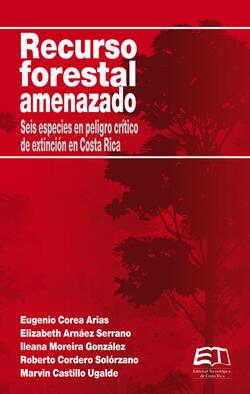Читать книгу Recurso forestal amenazado - Roberto Cordero - Страница 8
На сайте Литреса книга снята с продажи.
Abstract
ОглавлениеThis study aims to contribute with the conservation of the genetic diversity and the survival of six tree species in a critical situation to extinction (Cedrela salvadorensis, Platymisciumyucatanum, Paramachaerium gruberi, Cedrelafissilis, Ruagea insignis y Gamanthera herrerae), through the application of ex situ conservation and reproduction methods.
Exploration and location of remnant tres and populations was achieved by mean of field trips to different places in Costa Rica, starting more intensively in places previously cited by the literatura available in Costa Rica along with individual interviews to expertize collectors and professionals in botany and forestry At least ten indvidual trees were localized and referenced using goegraphical information technology.
Trees were visited frecuently in order to monitor their phenological events following standard protocols. Collection of seeds and seedlings was possible on those species where reproductive trees or abundant regeneration were found. Seed and seedling development was described from fresh material. Particular microscopic traits were registered with photographs obtained of samples prepared and observed under a scanning electron microscope.
Important reproductive limitations in several of the species and populations were identified, such as: absence of flowering, few trees producing viable seeds, small seed number produced and short and isolated seed production periods. recalcitrant seeds, lack of germination or low germination success, heterogeneous or slow fruit development, suprannual flowering events, and seed predation.
The almost total absence of young trees is noteworthy. Viable explanations for this situation include: genetic erosion, isolation and endogamy, lack of pollinators and seed dispersers, lack of suitable habitats and climate change.
In spite the numerous field explorations during this study, we were able to localize only one individual tree of Gamanthera herrerae and none of Cedrela fissilis. This condition suggests that C. fissilis is already extinct and G. herrerae is practically extinct in Costa Rica. This situation exemplifies the extreme and worrying situation of the endangered tree species and the relevance of this study.
Trees of the other four species (C. salvadorensis, P. yucatanum, P. gruberi y R. insignis) have been geographically referenced, seeds collected and ex situ genetic collections has been established. Successful methods of propagation from seed sources and protocols for massive vegetative propagation of two of these species has been developed using shoot cuttings subjected to several rooting and acclimation trials. The vegetative propagation for R. insignis is under development.
Our results show that implemented methodologies have a great potential to rescue the genetic variation and to reproduce endangered tree species, making possible to reintroduce them in those ecosystems genetically impoverished or extinct. These efforts must be used as a baseline for its cultivation in diverse agro-ecosystems, breeding within programs for domesticating and conservation.
Key words: Cedrela salvadorensis, Platymiscium yucatanum, Paramachaerium gruberi, Cedrela fissilis, Ruagea insignis, Gamanthera herrerae, forest species, forest species critically endangered tree species.
